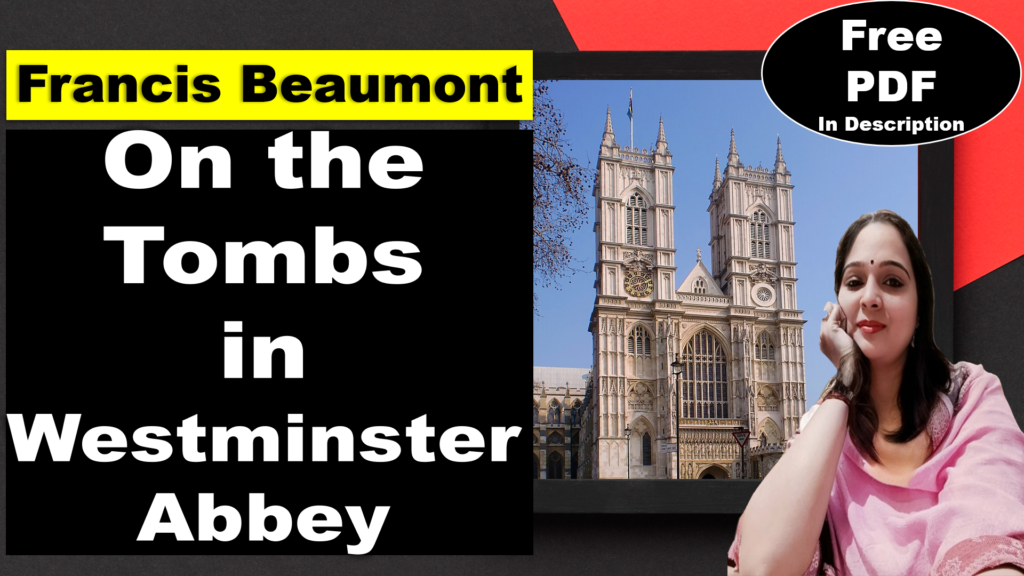
On the Tombs in Westminster Abbey Questions and Answers
Very Short Answer Questions
Who is the author of the poem?
The author of the poem is Francis Beaumont.
What is the setting of the poem?
The setting of the poem is Westminster Abbey, a notable burial site in London.
What is the central theme of the poem?
The central theme of the poem is the inevitability of death and the transience of earthly power and wealth.
What is the tone of the poem?
The tone of the poem is somber and reflective.
What style is the poem written in?
Simple and direct language, with occasional use of metaphor and personification .
What is the message of the poem?
The message of the poem is a reminder of our mortality and the fleeting nature of power and wealth.
Who is the speaker in the poem?
The speaker in the poem is an observer reflecting on mortality and the transience of earthly power and wealth.
What is the form of the poem?
The poem follows a rhyme scheme of AABBCCDDEEFFGGHHII and is written in iambic tetrameter.
What poetic device is used in the line “MORTALITY, behold and fear!”?
The poetic device used is personification.
What does the line “Think how many royal bones Sleep within this heap of stones” imply?
It implies the mortality of even the most powerful individuals.
What does the line “Where from their pulpits seal’d with dust They preach, ‘In greatness is no trust.’” mean?
It means that the tombs serve as a reminder that one cannot place trust in worldly greatness.
What does the line “Here ’s an acre sown indeed With the richest, royall’st seed” signify?
It signifies that the tombs are filled with the remains of once powerful and wealthy individuals.
What does the line “Here the bones of birth have cried— ‘Though gods they were, as men they died.’” convey?
It conveys that despite their god-like status in life, these individuals met the same fate as all humans – death.
What does the line “Here are sands, ignoble things, Dropt from the ruin’d sides of kings;” mean?
It means that the remains of the kings have been reduced to mere dust.
What does the line “Here ’s a world of pomp and state, Buried in dust, once dead by fate.” imply?
It implies that the grandeur and status that these individuals once enjoyed are now buried and returned to dust.
What is the mood of the speaker in the poem?
The mood of the speaker varies throughout the poem.
Short Answer Questions
1. What is the significance of the setting in the poem?
The poem is set in Westminster Abbey, a notable burial site in London. This setting is significant as it houses the tombs of many powerful and influential individuals, serving as a stark reminder of mortality and the fleeting nature of earthly power and wealth.
2. How does the author use imagery in the poem?
Beaumont uses vivid imagery to convey the themes of the poem. He describes the tombs as “pulpits sealed with dust” and the remains of the kings as “sands”, creating a vivid picture of death and decay.
3. What is the central message of the poem?
The central message of the poem is a reminder of our mortality and the fleeting nature of power and wealth. Despite the greatness and wealth one might achieve in life, everyone meets the same fate in death.
4. How does the author convey the theme of mortality in the poem?
Beaumont conveys the theme of mortality through the use of vivid imagery and metaphors. He describes the tombs as “pulpits sealed with dust” and the remains of the kings as “sands”, reminding the reader of the inevitability of death.
5. What is the tone of the poem and how does it contribute to the overall meaning?
The tone of the poem is somber and reflective. This tone invites the reader to contemplate the transience of life and the inevitability of death, reinforcing the poem’s central themes.
6. How does the author use personification in the poem?
Beaumont uses personification in several instances in the poem. For example, he addresses mortality as if it were a person and suggests that the tombs are preaching a lesson.
7. What is the significance of the line “Here ’s an acre sown indeed With the richest, royall’st seed”?
This line is significant as it uses the metaphor of sowing seeds in an acre to describe the burial of the once powerful and wealthy individuals. It underscores the theme of the transience of earthly power and wealth.
8. How does the author use alliteration in the poem?
Beaumont uses alliteration in the line “Here ’s a world of pomp and state, Buried in dust, once dead by fate.” The repetition of the ‘d’ sound in “dead by dust” adds a rhythmic quality to the line and emphasizes the theme of death.
9. What is the significance of the line “Though gods they were, as men they died”?
This line is significant as it underscores the theme of the poem – the inevitability of death. Despite their god-like status in life, these individuals met the same fate as all humans – death.
10. How does the poem reflect on the concept of power and wealth?
The poem reflects on the concept of power and wealth by highlighting their fleeting nature. It underscores the idea that no matter how much power or wealth one accumulates in life, death is the great equalizer.





